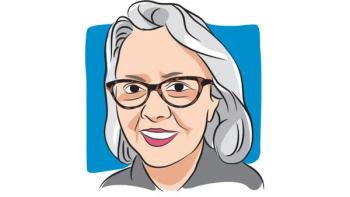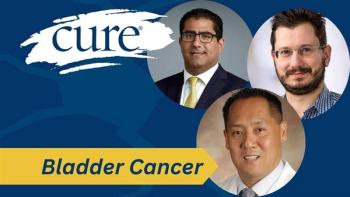
Why is Clinical Trial Enrollment Important for Those With Kidney Cancer?
Key Takeaways
- Clinical trial enrollment is vital for advancing renal cell carcinoma treatment, providing access to innovative therapies and potentially better care.
- The STELLAR-002 study evaluated zanzalintinib with Opdivo, with or without Opdualag, in metastatic kidney cancer, focusing on safety and efficacy.
Dr. Michael Serzan explains the importance of clinical trial enrollment for patients with kidney cancer and highlighted findings from the STELLA-002 trial.
Dr. Michael Serzan sat down for an interview with CURE to discuss the importance of clinical trial enrollment for patients with renal cell carcinoma, a type of kidney cancer, as well as discussed recent findings from the STELLA-002 study which were recently presented at the
“If you are eligible for a clinical trial, it's important to discuss the potential benefits of enrolling… We are firm believers that it's the only way we advance the science of the field. Many times, patients receive even better care while on clinical trials because we are actively trying to move the field forward and using tomorrow's treatments today,” Serzan emphasized in the interview.
Serzan serves as a medical oncologist in the Lank Center for Genitourinary Oncology at Dana-Farber Cancer Institute and is an instructor of medicine at Harvard Medical School, located in Boston.
CURE: To kick things off, what updates were shared from the phase 1b STELLAR-002 study at the 2025 ASCO Meeting?
Serzan: First, thank you so much for having me and for hosting this very important session to better inform patients and their caregivers about updates from ASCO 2025. My name is Dr. Michael Serzan, and I am a medical oncologist at the Dana-Farber Cancer Institute. I'm happy to walk through
For some context, this study was conducted for patients with metastatic kidney cancer, meaning cancer that had spread to distant parts of the body. We are very fortunate to have many treatment options that have not only helped patients live better, but also live longer. This particular study aimed to investigate a new combination of therapies designed not only to shrink cancer, but hopefully to achieve long-term control. It looked at the safety, tolerability, effectiveness of the drugs, and how long patients remained on the study.
The STELLAR-002 study was a phase 1 trial that utilized the new VEGF TKI (Vascular Endothelial Growth Factor Tyrosine Kinase Inhibitor), zanzalintinib (XL092). This medication primarily targets the blood supply of clear cell kidney cancer and is very similar to a drug called Cabometyx (cabozantinib), which is one of our foundational treatments for kidney cancer patients. The key difference is that zanzalintinib has a much shorter half-life. This means if patients experience side effects and need to discontinue therapy, we can stop the drug, and those side effects may resolve more quickly.
The STELLAR program combined zanzalintinib with Opdivo (nivolumab), which is one of our standard immunotherapies. The second arm of the study looked at zanzalintinib plus Opdivo and Opdualag (relatlimab-rmbw), a new immunotherapy drug that targets the LAG-3 receptor on the surface of immune cells. The study was truly trying to determine if there were differences in how well the drugs were tolerated and how effective they were at treating the cancer when comparing the zanzalintinib/Opdivo arm versus the zanzalintinib/Opdivo/Opdualag arm.
For patients who are newly diagnosed with clear cell renal cell carcinoma, how does this combination therapy of zanzalintinib and Opdivo with or without Opdualag compare to existing frontline treatment options ?
It's a great question, and one that we often discuss at our large annual meetings. I will put a caveat in that this was a small, relatively small study. It was a phase 1 trial with only 80 patients, 40 in each arm — designed primarily to see how well this combination was tolerated. When we try to compare it with currently available options, it’s important to remember those are different studies with different patient populations and medications, so it’s not a perfect comparison. However, we tend to make those comparisons anyway.
What I would say about the results from STELLAR-002 is that the side effects in the doublet — zanzalintinib plus Opdivo — versus the triplet — zanzalintinib plus Opdivo and Opdualag — were fairly similar. About a third of patients experienced side effects, which were [consistent] with what we typically see with these types of treatments. The most common ones were hypertension, diarrhea, liver and thyroid abnormalities, and skin rash. If patients experienced these side effects, we managed them by reducing doses or temporarily holding the medications.
One notable part of the presentation was that very few patients in either arm ended up stopping treatment altogether. Investigators seemed able to identify what was causing the side effects, hold the medication, and then resume treatment.
As for tumor responses: in the doublet arm, we saw a response rate of just over 60% and a disease control rate of about 90%. That means about 60% of patients had their tumors shrink, and about 90% had their tumors shrink or stay stable.
When we look at the triplet arm, we saw somewhat lower rates — a response rate around 40%, though the disease control rate was still about 90%. Again, small numbers here with 40 patients in each arm, but it’s intriguing; you’d think that the triplet would show a higher response rate versus the doublet, but we did not see that yet in this study.
We also looked at progression-free survival, which was actually a bit longer in the doublet arm at about 18 months versus about 13 months for the triplet. It is intriguing to see.
The primary end point was safety and tolerability, and these combinations seemed fairly similar in that regard. That said, it was a little [disappointing] that the triplet didn’t seem to produce better or longer responses. Still, this is a combination worth exploring, especially as we continue searching for new drugs and regimens for patients with kidney cancer.
Given that this was an early-phase study, what are the next steps before this combination could become more widely available or recommended as a standard of care?
The bar for kidney cancer is quite high. As I mentioned at the beginning, we are fortunate to have many combination therapies that work rather well, making it challenging to unseat or outperform those current standards of care. For patients with clear cell kidney cancer, which was the study population in STELLAR-002, we would need to see a phase 2 study demonstrating a bit more of the efficacy of this combination. Ultimately, it would need to be compared against some of our standard treatments before it could become available for patients.
I will say there is a clinical trial available for patients with non-clear cell kidney cancer that is comparing zanzalitinib plus Opdivo to Sutent (sunitinib). This is the STELLAR-304 study, a large trial that is truly trying to establish the role of zanzalitinib plus Opdivo in that non-clear cell population. We certainly look forward to seeing the results of that study and its potential to change care for patients with non-clear cell kidney cancer.
What should patients ask their care teams if they’re interested in participating in a clinical trial like STELLAR-002 or accessing similar therapies in the future?
That's a great question. I always tell patients, whenever they receive a new cancer diagnosis, to ask their care team — whether it's their oncologist, urologist, or radiation oncologist — "Do you think I'd be eligible for a clinical trial?" If they are, then they should understand what that clinical trial entails.
I want to address a common myth that many patients believe: that clinical trials are only for those who have exhausted all other treatment options. That couldn't be farther from the truth. As we saw in the STELLAR-002 study, this is a brand-new combination with biological rationale that we hope will improve the standard of care. All drugs ever approved for cancer patients have gone through this type of study. So, I want to dispel the notion that clinical trials are only for patients who have exhausted all lines of therapy. I firmly believe they play a crucial role for patients across the entire disease spectrum.
If you are eligible for a clinical trial, it's important to discuss the potential benefits of enrolling, the potential risks or downsides, and some of the logistics involved. If your institution doesn't offer a clinical trial, I think it's very important to ask for a second opinion at an institution that does, because we are firm believers that it's the only way we advance the science of the field. Many times, patients receive even better care while on clinical trials because we are actively trying to move the field forward and using tomorrow's treatments today.
Transcript has been edited for clarity and conciseness.
For more news on cancer updates, research and education,





